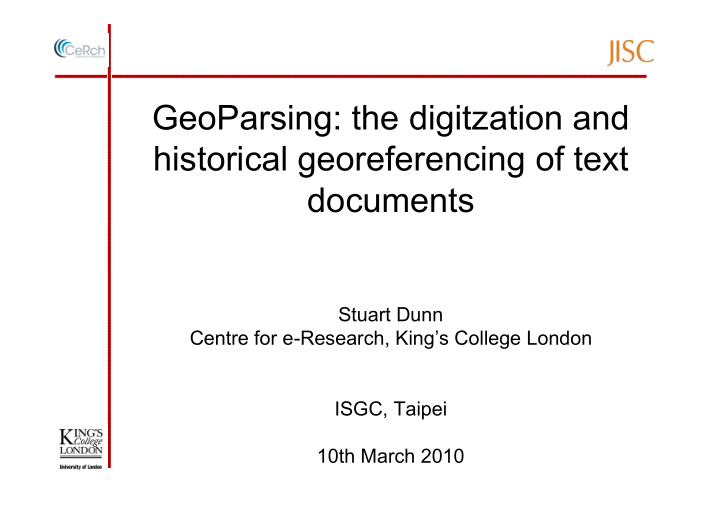



GeoParsing: the digitzation and historical georeferencing of text documents Stuart Dunn Centre for e-Research, King’s College London ISGC, Taipei 10th March 2010
• Bicameral parliament at Stormont 1921-1972 • Transcripts of all debates - Hansards • Fundamental aim - to broaden access
• 2004: Digitzation of Lower House Hansards (80 volumes) • 2008: Digitzation of Upper House Hansards (53 volumes) • Aim is to co-locate the collections in a single, sustainable repository • Georeferencing, based on NER approach
Georeferencing: basic principles • Informal : based on placenames • Formal : based on coordinates, or some other mathematical expression Benefits • Resolving ambiguity • Ease of access to data objects • Integration of data from heterogeneous sources • Resolving space and time
Gazetteer ID Geometric location Feature type Toponym
From the parsed text From a reference gazetteer
Problems:- • Identification of place names (as opposed to [e.g.] person names) • Disambiguation of place names (e.g. Belfast, Antrim versus Belfast, Maine) • Document structure - inevitably affects how the Geoparser works with individual corpora • Lack of standardized way of dealing with georeferencing • Only point data
Defining spatial footprints 34.87 24.87 ANDROS
Point data is problematic... 723 722 618722 721 617 618 169
• ‘Enforced crispness’ • The camera (or the geovisualization) never lies • Some attempts to improve this model, e.g. anchor theory, buffering procedures
Other applications
How do we get more out of digitization? • Not just about ‘linear’ reading • Need for authoritative cross-domain vocabularies and gazetteers, FTTs etc • Trusted repositories • Linking between resources • Useful and useable interfaces
Recommend
More recommend